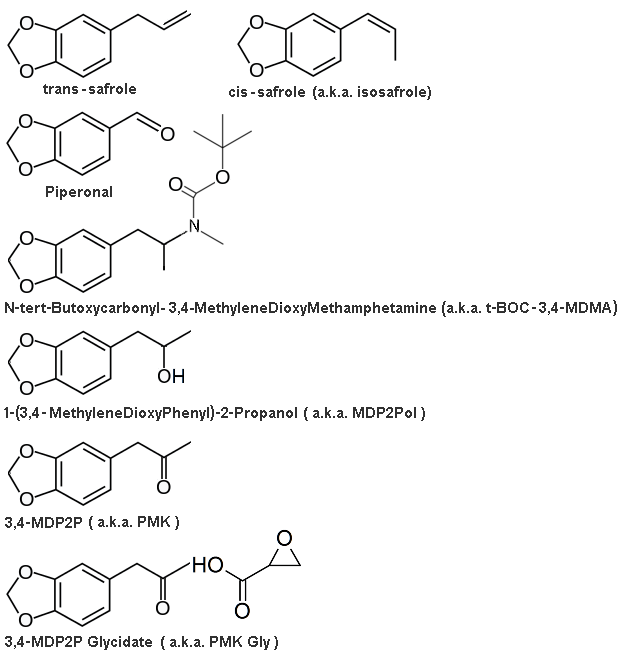Whilst I don't doubt that some labs cannot properly distinguish between certain regioisomers of MDMA, there's just no way a fully fledged government laboratory tasked by the authorities to precisely analyze all illicit substances for the purposes of prosecution, would mistake 2,3-MD for 3,4-MD. If the lab cannot distinguish these two then the whole process of reliably and accurately identifying potentially illegal substances would grind to a halt. In many jurisdictions 2,3-MD wouldn't even be prohibited and the system just would not tolerate a person being prosecuted for possessing or selling 3,4-MDMA if they in actual fact had 2,3-MDMA.
I continue to come back to the glycidate as being the genesis of the problem and the solution perhaps lies in what these labs actually do with this substance when making MDMA.
Of course high purity PMK glycidate can be easily turned into PMK, that can then be vacuum distilled to provide near pure PMK; this being surely near identical to similarly purified safrole produced PMK, with any MDMA manufactured from this being entirely awesome. However, this clearly isn't what is happening when we are talking about MDMA being made from this particular pre-precursor on an industrial scale.
Have a look at this article:
http://mixmag.net/feature/we-went-undercover-in-a-chinese-mdma-factory
Now put aside what you might legitimately think about the provenance of the article and instead focus on the quite extraordinary statement in the paragraph immediately after the photo of the road with the blue Asian street sign:
He revealed the details of his synthesis to me, and I verified the feasibility of the method with an equally expert but legitimate chemist. It wasn't just feasible, he told me; it was beautiful. "It achieves complex molecular changes in a single concerted step, almost like watching a solar system of planets align". "Elegant" is a good word for it, too. "It's the sort of thing that anyone [any organic chemist] could have come up with once it's explained to you, but really, the first person to come up with this [method] had quite a stroke of inspiration," he said.
If this is true then does anyone actually know what is happening in these reactions and what sort of products might be produced?
Earlier in this thread i cited a European article that confirmed that around the time of the switch to the glycidate, the reducing agent of choice used for the reductive amination step changed markedly from a borohydride to hydrogenation over a platinum metal catalyst. Why make this change unless the reaction is now substantially different to just using pure PMK and pure methylamine like the good old days; does this catalyst allow for a one reaction hydrolysis and reductive amination step which the earlier far more commonly used reducing agents did not?
If this is correct then any number of consequences might arise:
- the product would not be racemic especially if only one enantiomer of the chiral glycidate is used.
- what on earth is produced when the glycidate is hydrolyzed and would this also undergo reductive animation to produce who knows what kind of toxic alkyl amine in the same reaction (and which would be removed by advanced purification steps that others have discussed and which seems to greatly assist)
- there are multiple different PMK glycidate type pre-precursors being used already and no doubt the products resulting from a one ?step? or ?pot? amination to MDMA would vary wildly in nature and number, depending on the specific pre-precursor being used
- what impact might using heavy metal catalysts have on the purity of the product, especially if it is reused in massive reactions over and over again, with the catalyst no doubt being sourced from an industry that is not manufacturing chemicals for human consumption.
This simply confirms that we need to know, to a high degree of scientific detail, the answer to these questions:
(1) The identity of the various impurities found in samples of MDMA these days which are materially different from the sorts of impurities which have always been found in illicitly produced MDMA;
(2) The enantiomeric (S:R) ratio of the MDMA; is it racemic as many people still believe or are many samples out there skewed in a particular direction (likely the R if anything);
(3) The precise chemical identity of all the pre-precursors currently being used to manufacture MDMA; PMK glycidate is one but there are at least several more;
(4) What manufacturing methods are used to convert the pre-precursor to MDMA, in particular is: (i) MDMA being made via some type of "one-pot" synthesis or is there some attempt to extract and purify the PMK first, and (ii) what chemicals are used in the reductive amination part of the process; and
(4) What really happens at a molecular level when these glycidates/gycidic esters etc hydrolyze into separate components and do the "other components" involve themselves in later aspects of the process (or are otherwise not removed from the product produced) - people assume it is simple and assume these pre-precursors simply produce PMK to be used at the manufacturer's leisure in a later reaction, forgetting that there is an entire half a molecule floating around the vessel which is completely absent when purified PMK on its own.
Personally, I think the reality of what we are dealing with is potentially even more complicated than the nature of the discussions to date and which may reveal a considerably worse state of affairs than what we have arrived at currently (which is already bad enough!)
Any thoughts?





